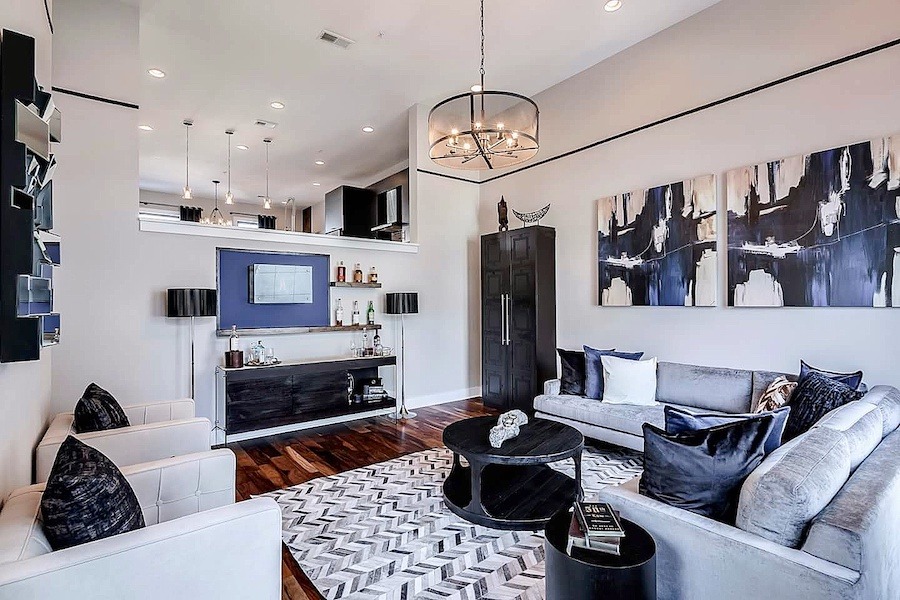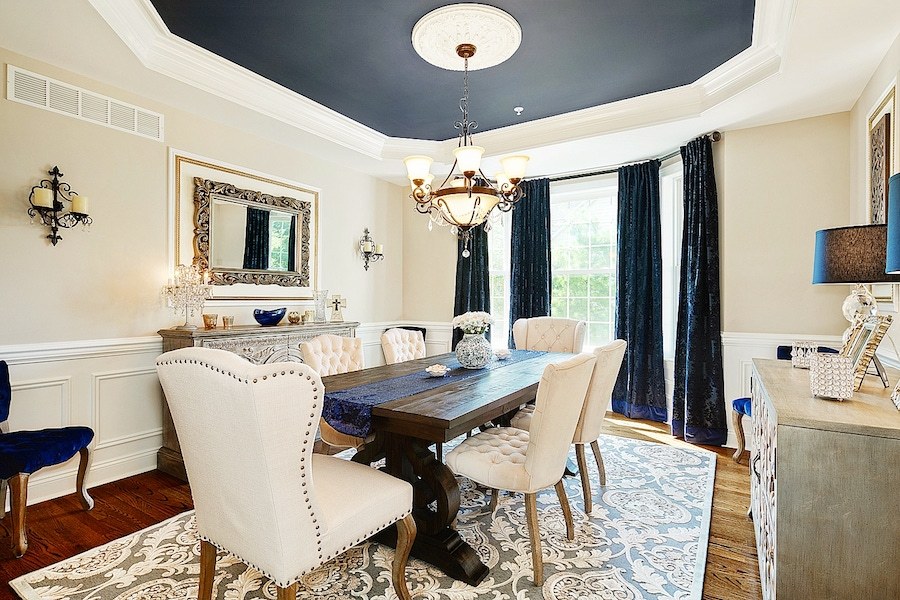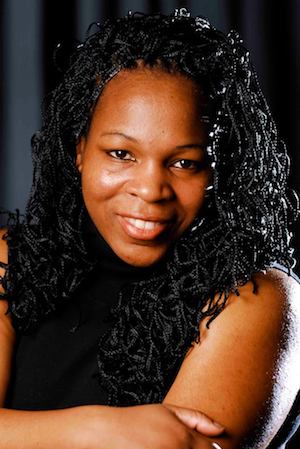Meet the Designing Women Who Hit a Home Run for Phillies Manager Gabe Kapler
"Trust the vision," Lauren and Wendy Nolan-Sellers told Gabe Kapler. He did, and the result was fantastic. Now this self-taught designer and her business-savvy partner are sharing with others a process their clients can trust.

The interior of Phillies Manager Gabe Kapler’s condo. | Photos courtesy Trust the Vision Decor
How many of us have watched interior-design and home-decor TV shows thinking, “Gee, I’d love to be able to do that?”
Lauren Nolan-Sellers wasn’t content to leave it at the dream stage. Instead, she and her business and life partner Wendy, taking a page from the Nike script, decided to just do it. Starting with their own Bucks County home, they have through trial and error built a solid interior design business that has racked up awards and many satisfied clients.
Including Phillies Manager Gabe Kapler, whose Philadelphia condo they turned into a sleek modern vision in blue and white.
And they did all this by following a simple principle: “Trust the vision.”
If this reminds you of the mantra Sixers fans have chanted for the past few seasons, that’s no accident, says Lauren.
“You’re gonna love it when we’re done”
“That’s exactly where it came from,” she says. “When we were working on different clients’ homes in the beginning, they’d come in in mid-project, and they would see just half the work done, and they’d get so nervous: ‘What are you doing? I don’t understand what this is.’ And in the beginning, we didn’t have the sophistication with renderings, so I would always say to them, ‘You gotta trust the vision. Just trust the vision, trust what we’re doing, I promise you’re gonna love it when we’re done, just trust the vision.'”
Wendy explains, “When you’re working with clients, there’s a huge element of trust. So it morphed into Trust the Vision Decor.”
Lauren had already put that principle to the test when the couple decided they wanted to buy a house of their own. “Up until then, you’re living under Mom and Dad’s rules, under college rules, or your landlord’s rules, so you can’t really do the things you want to do,” says Lauren.
Their own home becomes their first advertisement
When they became homeowners, all that went out the window, and Lauren was full of ideas planted in her head from watching scads of home-improvement shows on HGTV. “So Wendy said, ‘You know what? Here’s your chance. You seem to be really into this, here’s your chance to just go for it.’ So we did. We just jumped out there, with no experience, no connections, and we just started working on our own house.”
Their real estate agent, for one, was skeptical about their actually following through on their plans. But they did, and the result got a warm reception from their family and friends at their housewarming party. Soon enough, those same friends and family were asking Lauren for advice on redecorating their houses. “So we started giving advice, and that morphed into ‘You know, I will pay you to do this.’ And so, you know what? Maybe it’s time to get serious,” Lauren says. “And so I enrolled in design courses to really understand the elements and principles of what was going on, and that turned into launching the business” in 2012.
Somehow, the couple and the business both managed to survive the startup phase. It helped that their talents complemented each other: “I’m the creative side, and [Wendy] is really meticulous and organized and she does the numbers,” Lauren says. “So it’s easy to defer [to each other] because we have these clearly defined roles, but each of them is important to making the business work.”

A dining room in the neoclassical style for WMMR on-air personality Kathy Romano, another Trust the Vision client.
A space that’s “more me than I ever knew”
Lauren describes her design philosophy as follows: “We’re trying to create a space that reflects the client. It’s a space that’s functional and beautiful, but something that reflects them so that when they walk in the room they go, ‘Oh my gosh, this is so me. It’s more me than I ever knew.'”
Not only should the finished space be functional, beautiful and a reflection of the client, but the redesign should also be affordable for regular folks. “When I originally started and fell in love with design, it was to help everyday people who wanted a space to live in and wanted to make it beautiful, but they really didn’t know how, and they thought that design was out of their reach,” Lauren says.
As the accompanying photos should show, Trust the Vision can work in many different idioms, from the ultra-traditional to the sleek and modern. Individuals have eclectic tastes, so why shouldn’t their living spaces reflect those many moods?
While most Trust the Vision clients are indeed “everyday people,” the duo have done other projects for high-profile personalities. “Kathy Romano from WMMR, of the ‘Preston and Steve’ show, we recently finished her dining room,” Lauren says. “We have also done projects for some others who are not in the public eye.”
It’s all about the client

Lauren Nolan-Sellers, the designer half of Trust the Vision Decor
Both partners describe their approach as highly client-focused. “As we each have different roles, as we go through projects, each of us will see different things that we can make better, and so together we make constant improvements to make the best experience for the client,” Wendy says.
The quality and professionalism Lauren and Wendy bring to their work have earned Trust the Vision Decor “Best of Houzz” awards every year since 2015. It took them three years of trial and error, however, to get to this point.
And that was because interior design courses offered lots of guidance on the aesthetics and function of design, but none on the financial or operational aspects of running an interior design firm. So the two sort of had to make up their business and operating practices as they went along. “And while we were taking on all this, we were wasting so much time and effort and money making all of these mistakes,” Wendy says. “And we were looking for mentors, like, ‘How did someone do it before us?’ And there were none.”
That has led them to become the mentors they never had to other would-be designers through their other growing business, the Aspiring Designers Academy.
A Jumpstart for interior designers
Much as the Jumpstart programs teach would-be developers the rules of the game and get them started with their first projects, the two-month Aspiring Designers Academy course gives its students a set of best practices they can use to launch their own businesses, based on what the Nolan-Sellerses discovered worked for them.
And if these practices work for them, they figured, they might work for others too. Proof of that came from the very first designer who took their course. That student was a woman from North Carolina who, in Lauren’s words, “had a beautiful aesthetic, but she had actually gone out of business because she couldn’t figure out the business piece.
“So she enrolled with us, she took the course, and about a month ago, she called us and said, ‘I just wanted to let you know I was just chosen outstanding designer for custom spaces in the entire state of North Carolina by Life and Style magazine, and I wouldn’t have been able to do any of this without your course.'”
“We built a tribe”
Course graduates get plenty of support. They have access to a library of more than 50 videos about various aspects of design and a suite of some 35 downloadable forms and documents they can use to set up their own business. They can also get optional one-on-one followup coaching and advising from Lauren and Wendy, and there’s an online support community where graduates can share their triumphs and challenges.
They also get referrals: whenever one of the 30,000-plus followers of the Trust the Vision Decor Facebook page asks for recommendations for designers in their community, the Nolan-Sellerses will give them the name of an academy graduate in their area.
Continuing to do real design while they teach is essential to the academy’s success, Wendy says. That way, they keep current with design trends and issues: “We’re right there with you. We can say, Look, we have this client right now, and we’re experiencing the same thing you are, and this is how we’re dealing with it. Or this is a trend that we’re seeing, and what used to work over here doesn’t. You need to be able to keep [course participants and alumni] current as much as possible so they’re on the cutting edge of what’s going on.”
As of now, 15 people have graduated from the Aspiring Designers’ Academy in the year since they launched it, and five are currently taking the course.
“We built a tribe,” Wendy says. “And our tribe is everyone who’s walking down this road with us together. It’s not about competition. The world is waiting for it; there’s more than enough to go around. That’s what we believe.”


